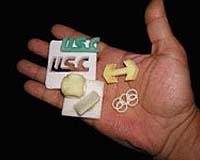 Plastic was to the 1960's what cryonics was to the 1980's -- symbolic of the Future. While freezing one's head after death never really made it to the mainstream, plastics are all around us. With a couple of recent developments, plastic may well again be the wave of the future.
Plastic was to the 1960's what cryonics was to the 1980's -- symbolic of the Future. While freezing one's head after death never really made it to the mainstream, plastics are all around us. With a couple of recent developments, plastic may well again be the wave of the future.
MIT has just announced the development of a new method for creating and forming plastics. Normally, plastic shapes are made at fairly high temperatures, melting polymers and pouring them into molds. Plastic objects made in this way have limited recyclability, as the heating and cooling process weakens the polymers -- so called "thermal degradation." The MIT method can shape plastics at room temperature using high pressure, resulting in "baroplastics" which can be reshaped with no thermal degradation. Plastic objects created with this process require less energy to be produced, too. Less energy use, more recyclable... works for me.
But squeezing plastics into shape isn't the only recent breakthrough. An Engineering professor at USC has invented a low-temperature method of doing plastic sintering, more popularly known as 3D printing or fabbing. 3D printers are a relatively recent invention, using powdered polymers (and, occasionally, metals) and a high-powered, laser to build up objects layer-by-layer. Originally used for rapid prototyping, 3D printers are now used by aerospace companies for direct manufacturing of components. The USC method dramatically reduces the heat necessary for sintering, which in turn greatly lowers the cost.
This is pretty big news. 3D printing, if brought down to consumer-level prices, would reshape the way we make and use various home and office products. If all you need to make a toy or kitchen device is a fabber, a supply of raw polymer powder, and a design file, how long before we see "Napster Fabbing?" Things get even more revolutionary if the plastics used can be easily recycled to be used for the next bit of 3D printing.
And we're not just talking about dolls, garlic presses, and iPod pouches. Electroactive polymers -- "flexonics" -- allow for electronic circuits to be embedded in fabbed objects. This would make printing out a new individually-fit ergonomic keyboard, for example, just as easy as printing out a coffee cup.
A plastic future may not be so bad...
Comments (7)
Although the next wave of plastic manufacturing sounds promising and very interesting, it still does not offer any solution to som of the basic problems that the plastic industry has created; waste. already plastics could be recycled much more than they are, but it has not happened yet for a veriaty of different reasons, both social and economical. The Plastics that have captured my imagination and suggest a positive future with a reasonable change in the consumers habits seems to be bioplastics.
Bioplastic got a bad name in the late 90's becuase they were selling lawn bags that biodegrade, which they did, unfortunately they biodegraded into microscopic plastic polymers that poisoned the ground and water. Since then there have been great advancements in the field of bioplastic, now the polymer (the building block) biodegrades instead on bond that holds them together (the morter). furthermore the polymers are now created from corn, an anually renewable resource, instead of petroleum which most plastics are made from. They have also figured out how to control how long the bioplastic will last before it will start to biodegrade.
For more information and positive test results look up the 2000 winter Olympics in Sidney Austrial were all the venders had to use packaging that was either recyclable or biodegradable. The main reason why we aren't seeing bioplastic in our daily lives is because it is still very expensive, and without either legislation or technology advancements to help even out the price, bioplastics will remain in the shadows.
Posted by Holden Whitmarsh | November 27, 2003 11:51 AM
Posted on November 27, 2003 11:51
Call me cynical and/or paranoid, but I somehow doubt that we'll ever see a Napster Fab (Fabster?) movement. Instead, we'll get a systems that lets us license furniture for limited periods, subject to annual fees. Electroactive polymers, combined with DRM, would mean that you could build objects that warp into useless shapes if you fall behind on your payments.
Posted by Mithra | November 28, 2003 12:53 PM
Posted on November 28, 2003 12:53
Another world *is* here: Bioplastic in our daily lives
Wild Oats Natural Marketplace (grocery stores) introduced "Made from Corn" plastic containers in its Portland, Oregon area stores last May. They've since expanded to other their markets as well.
The containers are biodegradable, but not in home compost bins, which don't get hot enough. Wild Oats collects the used containers and then transports them to a facility where they are composted.
The containers are made from Cargill Dow's NatureWorks PLA.
For more, please see: http://www.wildoats.com/app/cda/oat_cda.html?pt=Department&departmentId=29
Posted by Peter+Trudy Johnson-Lenz | December 17, 2003 5:30 PM
Posted on December 17, 2003 17:30
Biodegradable and compostable granulate for bioplastic products
Posted by Rodenburg Biopolymers | January 8, 2004 4:30 AM
Posted on January 8, 2004 04:30
i want hear more technical side of the plastic in the future.
m
Posted by max shale | January 15, 2004 8:25 AM
Posted on January 15, 2004 08:25
i am student needed information regarding bio platics in detail also soe technical data regarding tht.
Posted by arjavpandya | April 14, 2004 8:50 PM
Posted on April 14, 2004 20:50
need to know stuctures mechanisms etc for some bioplastics i.e. PLA orPHB NOWHERE HAS THEM!!!
thta would be cool thanks
Posted by marin fisher | May 4, 2004 4:27 AM
Posted on May 4, 2004 04:27